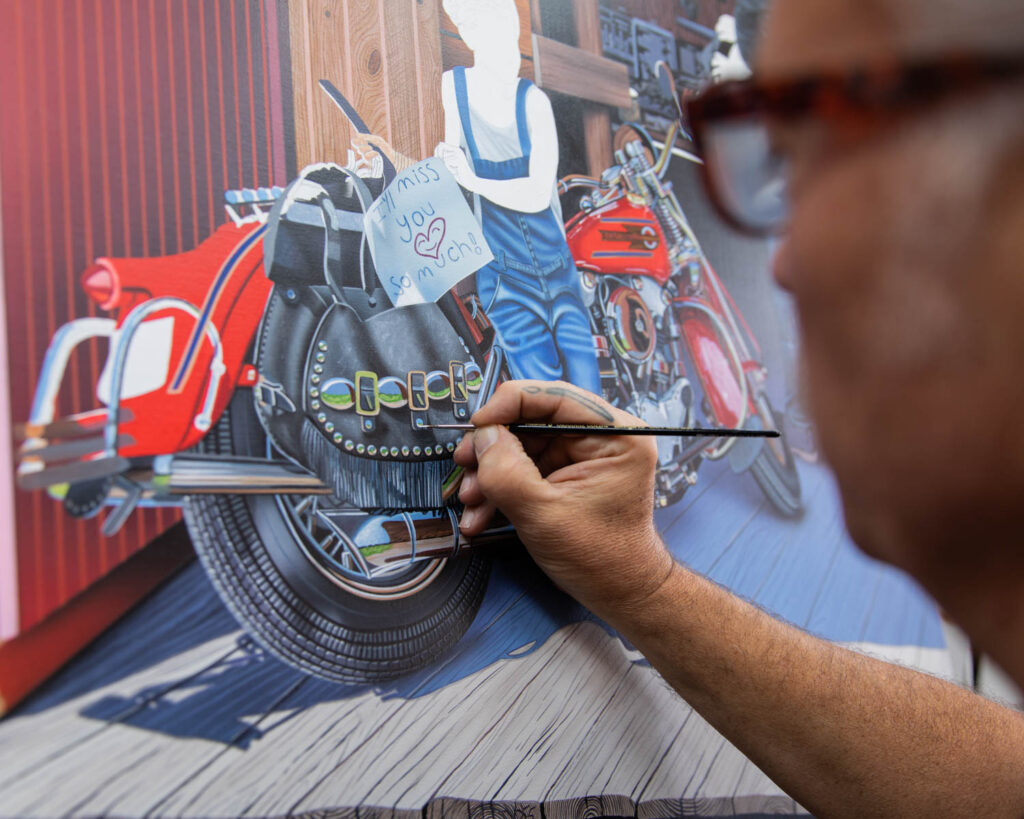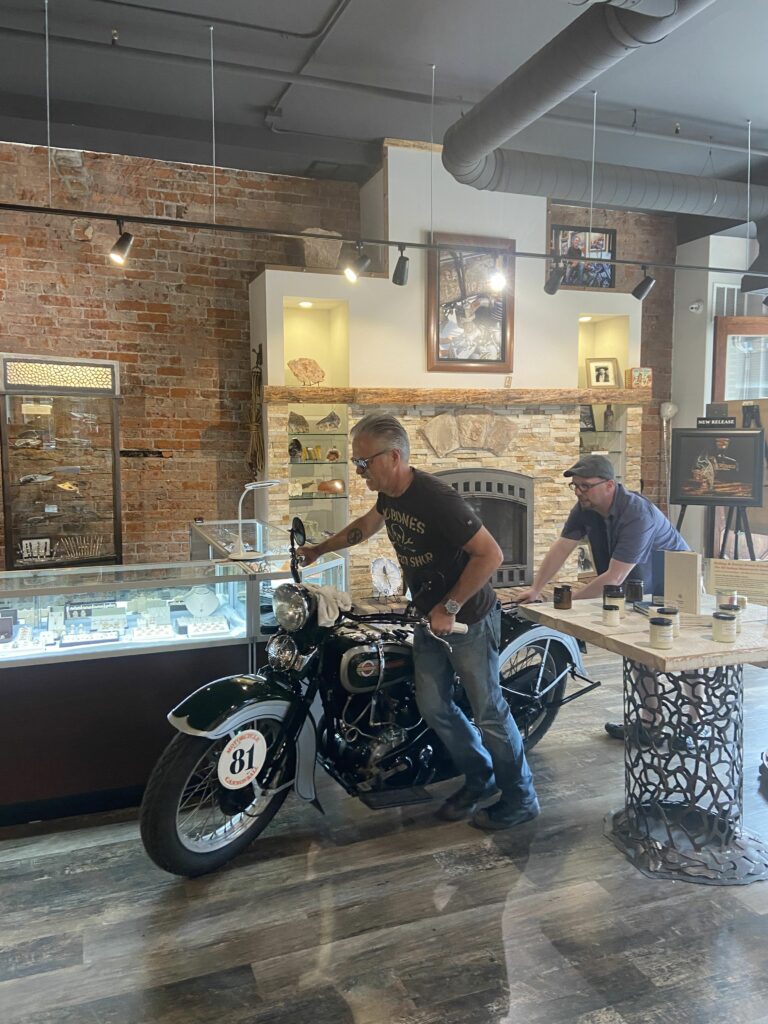In the realm where two distinct passions merge — the thrill of motorcycles and the captivating world of art, one name shines brightly, Scott Jacobs. His love for two wheels started as a motorcycle enthusiast, which eventually led him to becoming the first ever licensed Harley-Davidson artist. Scott has been proudly collaborating with the famous motorcycle brand for three decades.
Scott has meticulous attention to detail and an uncanny ability to capture the essence of the open road. Furthermore, Scott has left a permanent mark on the art and motorcycle community. With a wealth of artistic expertise accumulated over several decades, he ventured into establishing his own art gallery in the heart of Deadwood, South Dakota, called Scott Jacobs Gallery. Notably, his painting’s now fetch prices exceeding $300,000 — an extraordinary feat seldom witnessed among living artists. Get inspired by the passion and talent that have made Scott Jacobs a true icon in the art and motorcycle world. With this, he is cementing his place in history and capturing the essence of the Harley-Davidson spirit through his mesmerizing artworks.
Russ Brown Motorcycle Attorneys: Can you tell us a little bit about your journey to becoming the first licensed Harley-Davidson artist? How did you get started in the art world and what led you to focus on motorcycles and specifically Harley Harley-Davidson’s?
Scott Jacobs: I was doing celebrity portraits for years and then I started doing cars, and then I was on the phone with one of the guys that I’d bought art from for a long time. His name’s Ron Coppel. He goes, “Why don’t you paint motorcycles? Nobody’s really doing motorcycles.”
Live To Ride, the piece behind me was a photo I found in a book and I did a painting of it and I did another one of a 1990 Fat Boy. And then I brought them to what’s called an Art Expo in New York City. That’s a huge art event where gallery owners from all over the world, including Canada, would come and they would look at artists’ work and pick out art to carry in their galleries. At that event, I got this tap on my shoulder, and it was the Beanstalk Group. The Beanstalk Group is the licensing arm for Harley-Davidson out of New York City. And they said, “Well, we see these Harley pieces here, you can’t do that.” And I said, “What do you mean I can’t do that?” They said, “Well, you have to be licensed to paint our nomenclature.”
And then this other Art Expo event happens in New York, and it also happens in Los Angeles as well. So, I did the Los Angeles one, and those same people came to that show. They were walking around the event with Jeff Bluestein, who was the chairman of the board of Harley-Davidson at the time. They come into the booth and Jeff goes, “Is this the guy you were talking about?” — “Yeah, we’ve already sent him a cease and desist.” Jeff goes, “This stuff’s really nice.” He goes, “Why don’t we try to work something out?” So three months later, long story short, I became the first licensed artist in the world to produce fine art paintings for Harley-Davidson, which means that the images are in their archives

Caption: Scott in the process of painting Daddy’s Girl (Photo: Owned by Scott Jacobs)
Russ Brown Motorcycle Attorneys: You have a lot of great detail and realism in all your work, especially the motorcycles that you paint. Can you walk us through what your artistic process is from concept to completion?
Scott Jacobs: To give you an idea, a lot of the images over the years have come from life. Life experiences of being a part of the motorcycle industry. Certain bikes that I’ve seen around the country or around the world with really cool backgrounds. I’ve noticed over the years that when I paint vintage motorcycles, the audience is bigger. Once I have a bike picked out for a piece, I have an idea. I might do a pencil sketch, thumbnail sketch to figure out the composition and then I try to capture the composition or the idea in my mind in photo reference so I have something to work from.
Russ Brown Motorcycle Attorneys: You still have this great partnership with Harley-Davidson where you’re still able to work with them 30 years later!
Scott Jacobs: I love Harley-Davidson. I’ve painted some other brands. They’re the company that I love and that I like to stand behind, and I promote all the bikes in my gallery. I have nine vintage bikes down there. They’re all Harley-Davidson’s. I don’t have any Indians down there or any competing motorcycles. They told me early on when I started doing the Harleys that they would prefer if I didn’t paint anything that was in competition with Harley-Davidson, meaning somebody that was in business at the same time.

Caption: Scott taking a photograph for creative inspiration (Photo: Owned by Scott Jacobs)
Russ Brown Motorcycle Attorneys: You’ve been a regular attendee at Sturgis for quite some time and your art has become a fixture of the event. Can you tell us about your first Sturgis experience?
Scott Jacobs: It was amazing. It was so cool. My first time at Sturgis was in ’94. I run into some guys I’m talking to and I don’t know who they are. One of them was Arlen Ness, the world-famous bike builder. He became an amazing friend — his whole family are great friends of ours. So, I met Arlen Ness, Barry Cooney, Keith Ball, the editor of Easyriders Magazine and Mike Corbin of Corbin Seats. I met all these people the first year and they’re like, “Oh wow, your work is great.” Mike Corbin even buys two of my paintings and then Keith Ball says, “I’m gonna do an article about you and Easyriders Magazine.” I’m like, “Wow, great.” Then I met Buzz Kanter of American Iron Magazine. Next thing I know, I’m on the cover of American Iron Magazine.

Caption: Scott posing with his painting Moments Like These (Photo: Owned by Scott Jacobs)
Russ Brown Motorcycle Attorneys: I would love to know what’s looking ahead for you. What are your plans and your goals for the future of your art and your career in the motorcycle industry?
Scott Jacobs: I love doing it. You know, the reason that I love motorcycles is because I’m all about detail. Painting a motorcycle, especially an antique bike that’s all chipped up and rusted and all these braided lines and stuff. It is such a challenge as a photorealist detail-oriented artist. So, believe it or not, after all these years, I am still so motivated to stand in front of a blank canvas just to see what I can do.

Caption: Scott with a classic Harley-Davidson motorcycle in his gallery (Photo: Owned by Scott Jacobs)

Caption: Scott putting realism to work with every painting he does (Photo: Owned by Scott Jacobs)
Russ Brown Motorcycle Attorneys: Have you considered doing any NFTs with your work now that it is the latest and greatest with artwork?
Scott Jacobs: I have been asked a couple times and I’ve said no because I don’t think I understand it, to be honest with you. From what I understand, basically, I’d be giving up my rights to all these images that I’ve done over the years and I don’t really want to do that because I don’t know where they would go. I like owning them
Russ Brown Motorcycle Attorneys: Have you ever been in a motorcycle accident? If so, what did you learn?
Scott Jacobs: Yes. I learned that pavement is really, really hard.
Russ Brown Motorcycle Attorneys: What road trip or ride have you taken that has given you the most inspiration for any of your work or even a specific piece of work?
Scott Jacobs: I’m sitting in my gallery right now on Main Street in Deadwood — the center of motorcycle Mecca of the United States. I love riding around the Black Hills. I think that’s why Sturgis Rally has gotten so huge over the years because it’s such an amazing place to ride.
If you want to learn more about Scott Jacobs and his artwork, check out his website or join his artistic journey on Instagram. Make sure to visit his art gallery in Deadwood, South Dakota! Ride safe, and thanks for reading!










